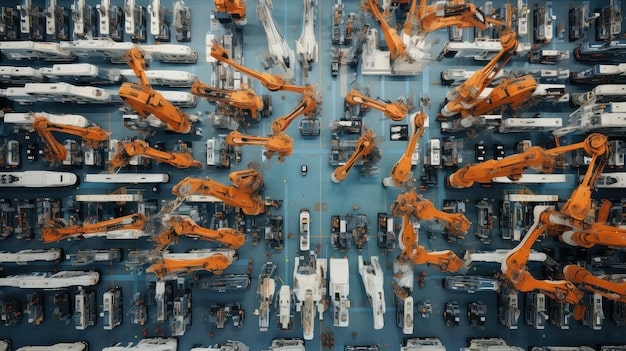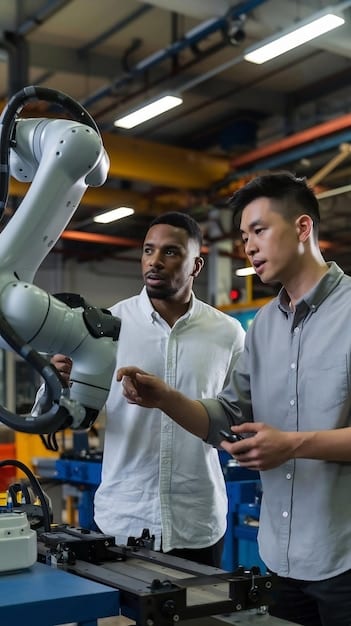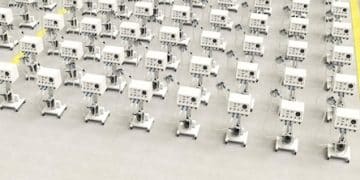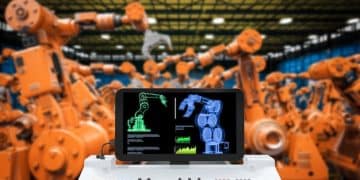US Robotics Regulations & Your 2025 Automation Plans

The potential impact of new US robotics regulations on 2025 automation plans for businesses can range from minor operational adjustments to significant strategic overhauls, largely depending on the scope and enforcement of upcoming legislation focusing on safety, ethics, and labor implications.
As 2025 approaches, many businesses are keen to understand: Will New US Robotics Regulations Impact Your 2025 Automation Plans? The landscape of robotics and automation is evolving rapidly, bringing with it both immense opportunities and complex challenges. Companies currently leveraging or planning to integrate advanced robotic systems must stay abreast of potential legislative shifts that could redefine their operational strategies, investment decisions, and compliance frameworks.
Understanding the Shifting Regulatory Landscape
The rapid acceleration in robotics adoption, particularly across manufacturing, logistics, and even service industries, has naturally drawn the attention of policymakers. While innovation continues at breakneck speed, concerns around safety, data privacy, ethical deployment, and labor displacement are prompting calls for clearer regulatory frameworks. These frameworks, currently in various stages of discussion and development, aim to balance fostering technological advancement with safeguarding public interest and workforce stability. Companies planning automation must recognize that the “wild west” era of unregulated robotics is drawing to a close, necessitating a proactive approach to compliance.
Current State of Robotics Regulation in the US
The United States currently lacks a single, comprehensive federal law specifically governing robotics. Instead, regulation is a patchwork of existing laws designed for other purposes, such as worker safety (OSHA), data privacy (various state and federal laws), and product liability. This creates a complex and sometimes ambiguous environment for businesses. However, federal agencies like NIST (National Institute of Standards and Technology) and even the Department of Defense are actively involved in developing standards and best practices that, while not strictly regulatory, often inform future legislation. This fragmented approach means businesses often navigate multiple, sometimes overlapping, sets of guidelines.
- OSHA Guidelines: Primarily focuses on workplace safety, ensuring robots do not pose undue risks to human workers through collisions or unintended operations.
- State-Level Data Privacy Laws: Regulations like the California Consumer Privacy Act (CCPA) can impact robots that collect personal data, especially in service sectors.
- Product Liability: Manufacturers and deployers of robots can be held liable for defects or malfunctions causing harm, pushing for robust testing and safety protocols.
Emerging Areas of Legislative Focus for 2025
Looking towards 2025, several key areas are emerging as priorities for potential new US robotics regulations. These include enhanced safety standards, ethical AI principles embedded in robotic systems, data security measures for autonomous devices, and frameworks to address the economic and social impacts of automation on the workforce. Discussions are also underway regarding accountability in autonomous decision-making and the legal standing of AI-driven systems. Businesses need to monitor these discussions closely, as they represent the most likely avenues for future legislative action.
Potential Regulatory Pillars: What to Expect
As the US grapples with the widespread integration of robots, several key regulatory pillars are likely to emerge, fundamentally shaping how automation is deployed and managed. These pillars aim to create a balanced environment that encourages innovation while mitigating risks. Understanding these potential areas of focus is crucial for businesses as they formulate their 2025 automation strategies. The anticipation of these pillars should guide preliminary assessments and risk management efforts.
Enhanced Safety and Operational Standards
One of the most immediate and tangible impacts of new regulations will likely be a significant uplift in safety and operational standards for robotic systems. This extends beyond basic physical safety in manufacturing to include the secure operation of autonomous systems in public spaces. Think of delivery robots navigating sidewalks or drones inspecting infrastructure; new rules might dictate communication protocols, sensor accuracy, and emergency braking systems. Compliance will mean investing in more robust testing, certification, and potentially redesigning existing systems to meet heightened safety thresholds.
Standards could encompass:
- Interoperability Requirements: Ensuring different robotic systems can communicate safely and effectively, especially in shared environments.
- Certification Processes: Mandatory third-party certification for specific categories of robots, particularly those operating near humans or in critical infrastructure.
- Fail-Safe Mechanisms: Stricter requirements for redundant safety systems, emergency stops, and autonomous shutdown protocols in case of malfunction.
These regulations are not merely about preventing accidents; they aim to build public trust in robotics, a critical component for widespread adoption.
Ethical AI and Accountability Frameworks
The ethical implications of AI-driven robotics are a growing concern. Regulations in this domain could focus on ensuring transparency in decision-making algorithms, preventing discriminatory outcomes, and establishing clear lines of accountability when a robotic system makes an error. This means businesses might be required to demonstrate how their AI systems are trained, what data they use, and how they mitigate biases. It also raises complex legal questions about who is responsible when an autonomous robot causes harm — the manufacturer, the deployer, or the programmer.
Data Privacy and Security Obligations
Robotic systems often collect vast amounts of data, from sensor readings in a factory to facial recognition data in service robots. New regulations are likely to impose stricter data privacy and security obligations, mirroring or extending existing laws like GDPR or CCPA. This could mean mandatory encryption for data gathered by robots, strict protocols for data retention and anonymization, and requirements for robust cybersecurity measures to prevent hacking or data breaches. Companies must consider how their robotic fleets handle sensitive information and ensure compliance with evolving data protection laws.
Labor and Workforce Transition Directives
Perhaps one of the most politically sensitive areas, regulations impacting labor and workforce transition due to automation, are a strong possibility. While generally slower to materialize due to their economic breadth, discussions around “robot taxes,” retraining programs, or mandatory impact assessments are gaining traction. Businesses might be required to invest in reskilling displaced workers, provide advance notice of automation deployments, or contribute to funds supporting workers transitioning to new roles. The goal is to soften the blow of job displacement and foster a more equitable shift towards an automated economy.

Navigating the Compliance Maze
The introduction of new robotics regulations presents a significant challenge for businesses, transforming what was once a relatively unencumbered innovation process into a structured compliance journey. Navigating this maze effectively will require foresight, strategic planning, and a deep understanding of the evolving legal and ethical landscape. It’s no longer enough to simply deploy the latest technology; companies must now ensure their automation strategies are inherently compliant and future-proof.
Assessing Your Current Automation Footprint
The first step in addressing potential new regulations is a comprehensive assessment of your existing automation footprint. This involves cataloging all robotic systems, understanding their operational parameters, the data they collect, and their interactions with human workers and the public. A thorough audit will reveal areas of potential non-compliance or vulnerability under future regulations. This might include older systems with less robust security features or operational protocols that don’t meet emerging ethical standards. Identifying these gaps early allows for proactive adjustments, rather than reactive remediation.
Key areas for assessment:
- Identify all automated systems, from industrial robots to AI-driven software.
- Document data collection practices, storage, and usage for each system.
- Review current safety protocols and human-robot interaction guidelines.
- Evaluate the ethical considerations embedded in AI algorithms and decision-making processes.
Developing a Proactive Compliance Strategy
With an understanding of potential regulatory shifts and areas of vulnerability, businesses can develop a proactive compliance strategy. This involves not only planning for adherence to anticipated laws but also actively engaging with standards bodies and policy discussions. Early adoption of best practices, even before they become law, can position a company as a leader in responsible automation. This strategy should also include allocating resources for retraining staff, updating hardware/software, and potentially overhauling operational procedures. A forward-thinking approach minimizes disruption and fosters confidence among stakeholders.
A proactive strategy might include:
- Internal Policy Development: Establishing company-specific guidelines that integrate anticipated regulatory requirements.
- Technology Upgrades: Planning for system upgrades that enhance security, safety, and ethical AI capabilities.
- Employee Training and Reskilling: Investing in programs that prepare the workforce for new roles alongside advanced robotics.
The Role of Industry Standards and Best Practices
Even in the absence of explicit governmental regulations, adherence to industry standards and best practices becomes paramount. Organizations like ASTM International, IEEE, and ISO are continuously developing guidelines for robotic safety, performance, and ethical AI. These standards often form the bedrock for future governmental regulations. By conforming to these voluntary standards now, businesses can establish a strong foundation for future compliance and demonstrate a commitment to responsible automation. They also provide a common language and framework for developers and users, fostering safer, more reliable deployments.
Impact on Different Industry Sectors
The potential impact of new US robotics regulations will not be uniform across all industry sectors. Each sector, with its unique operational characteristics, risk profiles, and historical regulatory frameworks, will face distinct challenges and opportunities. Understanding these sector-specific nuances is crucial for companies to tailor their automation plans effectively and strategically. From manufacturing to healthcare, the implications will vary significantly, requiring specialized attention and adaptive strategies.
Manufacturing and Logistics
The manufacturing and logistics sectors are already heavily automated, making them prime candidates for the initial wave of regulatory impact. Here, regulations concerning worker safety (human-robot collaboration), data security (interconnected supply chains), and the ethical deployment of AI in decision-making (e.g., predictive maintenance, autonomous scheduling) are particularly relevant. Companies might face stricter requirements for risk assessments, system certifications, and perhaps even mandates for human oversight in critical automated processes. The increased scrutiny will necessitate a re-evaluation of existing robot fleets and a thorough review of their compliance with emergent standards.
Healthcare and Service Robotics
For healthcare and service robotics, the regulatory focus will likely intensify around patient privacy, data security, and ethical considerations surrounding direct human interaction. Robots assisting in surgeries, dispensing medication, or providing elder care involve sensitive personal data and direct physical contact, demanding the highest levels of safety and accountability. Regulations could mandate rigorous testing, psychological impact assessments for vulnerable populations, and clear consent protocols. In service industries, robots interacting with the public might face rules on transparency regarding their AI capabilities and data collection practices.
Autonomous Vehicles and Drones
While often considered a separate category, autonomous vehicles (AVs) and drones are essentially mobile robots, and they are already subject to significant regulatory debate. For 2025, we can expect increased standardization in testing, certification for different levels of autonomy, and clearer liability frameworks for accidents. The integration of these systems into public infrastructure (e.g., smart cities) will also necessitate protocols for communication, data sharing, and security. The complexity of these systems, operating in dynamic and unpredictable environments, ensures they will remain a high-priority area for lawmakers, impacting logistics, delivery, and public safety applications.

Strategic Planning for 2025 and Beyond
As the shadow of potential new US robotics regulations looms, strategic planning for 2025 and beyond becomes not just advisable, but essential. Businesses can no longer afford to view automation solely through the lens of efficiency and cost savings. Instead, a multi-faceted approach that integrates compliance, ethical considerations, and long-term societal impact is paramount. This forward-looking perspective will not only mitigate risks but also position companies as leaders in responsible technological adoption.
Rethinking R&D and Investment
New regulations will inevitably influence research and development (R&D) priorities and investment strategies. Companies may need to allocate more resources towards developing “regulation-ready” robots – systems designed from the ground up with enhanced safety features, transparent AI, and robust data privacy protocols. This could shift investment away from purely performance-driven metrics towards compliance and ethical integration. Additionally, partnerships with legal experts and regulatory consultants will become increasingly vital to ensure R&D efforts align with anticipated legislative requirements, potentially slowing down rapid prototyping but fostering more sustainable innovation.
Enhancing Workforce Development and Reskilling
The human element remains critical in the age of automation. Proactive businesses will invest significantly in workforce development and reskilling initiatives. This goes beyond simply training employees to operate robots; it involves preparing them for new roles that leverage human strengths in collaboration with automation, such as robot maintenance, data analysis, ethical AI oversight, and human-robot interaction design. Such investments not only address potential regulatory demands regarding labor impact but also ensure a skilled workforce capable of maximizing the benefits of automation while adapting to evolving operational landscapes. This approach transforms a potential liability into a strategic asset.
Advocacy and Engagement with Policymakers
Ignoring the regulatory process is a perilous strategy. Savvy businesses (and industry associations) will engage actively with policymakers, providing expert insights, sharing best practices, and advocating for regulations that are both effective and practical. This includes participating in public consultations, lobbying efforts, and forming industry consortiums to collectively inform the legislative agenda. By doing so, companies can help shape regulations to be more balanced, preventing overly burdensome or technologically impractical mandates. Active engagement fosters a collaborative environment, benefiting both industry and the regulatory bodies.
Anticipating and Adapting: Key Takeaways
The prospect of new US robotics regulations in 2025 presents a complex yet manageable challenge for automation plans. While the exact scope and timing of these regulations remain fluid, the direction of legislative intent is clear: a greater emphasis on safety, ethics, data privacy, and the societal impact of automation. Businesses that proactively anticipate these shifts and integrate them into their strategic planning will be better positioned to thrive. It’s about building a resilient, ethical, and compliant automation strategy that navigates both innovation and responsibility.
Ultimately, the impact on your 2025 automation plans will depend directly on your ability to adapt. Companies that prioritize flexible, human-centric design, invest in robust compliance frameworks, and engage constructively with the evolving regulatory landscape are likely to find opportunity amidst the change. Those who merely react risk significant disruption and competitive disadvantage. The future of robotics is not just about technological prowess, but also about responsible deployment.
Therefore, as you refine your automation blueprints for the coming years, consider regulatory foresight as an indispensable component of your strategic toolkit. This forward-thinking approach will ensure that your robotic systems are not only cutting-edge but also operate within the bounds of a well-defined and responsible framework, yielding sustainable benefits for all stakeholders.
| Key Point | Brief Description |
|---|---|
| 📊 Shifting Landscape | US robotics regulations are moving from fragmented to more comprehensive, focusing on safety, ethics, and privacy. |
| 🛡️ Key Pillars Expected | Expect enhanced safety standards, ethical AI frameworks, stricter data privacy, and labor transition directives. |
| ♟️ Proactive Planning | Assess current automation, develop proactive compliance strategies, and adhere to industry best practices. |
| 🚀 Strategic Adaptation | Rethink R&D, invest in workforce reskilling, and engage with policymakers to shape future regulations. |
Frequently Asked Questions About Robotics Regulations
While compliance might add initial design and testing phases, it’s unlikely to significantly slow innovation long-term. Instead, it will likely steer innovation towards safer, more ethical, and more transparent systems. Many view regulations as a necessary step to build public trust, which in turn fosters wider adoption and more sustainable market growth.
Manufacturers might need to enhance safety features, implement more robust data encryption, improve transparency in AI decision-making, and ensure their systems are more easily auditable. This could involve upgrading sensors, modifying software algorithms, or incorporating standardized communication protocols for interoperability. Documentation processes for compliance are also expected to become more rigorous.
SMBs might face greater challenges due to limited resources for compliance, necessitating careful budgeting and strategic planning. However, many new regulations will likely be tiered or offer guidance tailored for smaller entities. Leveraging industry associations and off-the-shelf compliant solutions will be crucial for SMBs to navigate these changes effectively without excessive burden.
While the concept of a “robot tax” has been discussed, particularly as a way to fund workforce retraining, it’s highly uncertain whether such a measure would be implemented by 2025. Legislative processes are slow, and consensus on such a novel tax is far from guaranteed. However, businesses should monitor discussions around labor impact and potential funding mechanisms for displaced workers.
International standards from bodies like ISO and IEEE will likely heavily influence US regulations. Adopting globally recognized best practices can help create a more harmonized regulatory environment, facilitating cross-border trade and development in robotics. US policymakers often reference and adapt established international standards to inform domestic legislation, ensuring global compatibility and safety.
Conclusion on 2025 Robotics Regulations
The trajectory of robotics in the US is undeniably heading towards a more regulated future. While the specifics of potential 2025 regulations remain under development, the overarching themes of safety, ethical AI, data security, and workforce impact are clear. Businesses that integrate these considerations into their automation strategies now, rather than waiting for mandates, will not only ensure compliance but also build a more resilient, trustworthy, and ultimately successful automated future. Proactive engagement, strategic planning, and a commitment to responsible deployment are the hallmarks of companies poised to thrive in this evolving landscape.





